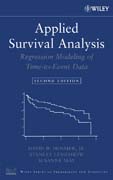
Applied survival analysis: regression modeling of time to event data
Hosmer, David W.
This book fills this gap, providing a comprehensive, self-contained introduction to regression modeling used in the analysis of time-to-event data in epidemiological, biostatistical, and other health-related research. Unlike other texts on the subject, it focuses almost exclusively on practical applications rather than mathematical theory and it offers clear, accessible presentations ofmodern modeling techniques supplemented with real-world examples and case studies. INDICE: Preface. 1. Introduction to Regression Modeling of Survival Data. 1.1 Introduction. 1.2 Typical Censoring Mechanisms. 1.3 Example Data Sets. Exercises. 2. Descriptive Methods for Survival Data. 2.1 Introduction. 2.2 Estimating the Survival Function. 2.3 Using the Estimated Survival Function. 2.4 Comparison of Survival Functions. 2.5 Other Functions of Survival Time and Their Estimators. Exercises. 3. Regression Models for Survival Data. 3.1 Introduction. 3.2 Semi-Parametric Regression Models. 3.3 Fitting the Proportional HazardsRegression Model. 3.4 Fitting the Proportional Hazards Model with Tied Survival Times. 3.5 Estimating the Survival Function of the Proportional Hazards Regression Model. Exercises. 4. Interpretation of a Fitted Proportional Hazards Regression Model. 4.1 Introduction. 4.2 Nominal Scale Covariate. 4.3 ContinuousScale Covariate. 4.4 Multiple-Covariate Models. 4.5 Interpreting and Using the Estimated Covariate-Adjusted Survival Function. Exercises. 5. Model Development. 5.1 Introduction. 5.2 Purposeful Selection of Covariates. 5.2.1 Methods to examine the scale of continuous covariates in the log hazard. 5.2.2 An example of purposeful selection of covariates. 5.3 Stepwise, Best-Subsets and Multivariable Fractional Polynomial Methods of Selecting Covariates. 5.3.1 Stepwiseselection of covariates. 5.3.2 Best subsets selection of covariates. 5.3.3 Selecting covariates and checking their scale using multivariable fractional polynomials. 5.4 Numerical Problems. Exercises. 6. Assessment of Model Adequacy. 6.1 Introduction. 6.2 Residuals. 6.3 Assessing the Proportional Hazards Assumption. 6.4 Identification of Influential and Poorly Fit Subjects. 6.5 AssessingOverall Goodness-of-Fit. 6.6 Interpreting and Presenting Results From the Final Model. Exercises. 7. Extensions of the Proportional Hazards Model. 7.1 Introduction. 7.2 The Stratified Proportional Hazards Model. 7.3 Time-Varying Covariates. 7.4 Truncated, Left Censored and Interval Censored Data. Exercises. 8.Parametric Regression Models. 8.1 Introduction. 8.2 The Exponential Regression Model. 8.3 The Weibull Regression Model. 8.4 The Log-Logistic Regression Model. 8.5 Other Parametric Regression Models. Exercises. 9. Other Models and Topics. 9.1 Introduction. 9.2 Recurrent Event Models. 9.3 Frailty Models. 9.4 Nested Case-Control Studies. 9.5 Additive Models. 9.6 Competing Risk Models. 9.7 Sample Size and Power. 9.8 Missing Data. Exercises. Appendix 1: The Delta Method. Appendix 2: An Introduction to the Counting Process Approach to Survival Analysis. Appendix 3: Percentiles for Computation of the Hall and Wellner Confidence Band. References. Index.
- ISBN: 978-0-471-75499-2
- Editorial: John Wiley & Sons
- Encuadernacion: Rústica
- Páginas: 416
- Fecha Publicación: 16/04/2008
- Nº Volúmenes: 1
- Idioma: Inglés
